by Cheryl Eagan-Donovan
This year’s 25th anniversary edition of PIFF included lots of big budget premieres, both international and locally shot films, and as always, really great parties.
Producer Vicki Oleskey and I arrived by the fast ferry from Boston on Wednesday afternoon and headed to our AirBnb house in the East End. After picking up a few provisions at the East End Market, we met fellow Chlotrudis Society members Michael Colford and Beth Curran for a casual dinner at J.D. ‘s on Commercial Street before going to the opening night film at the Town Hall next door.
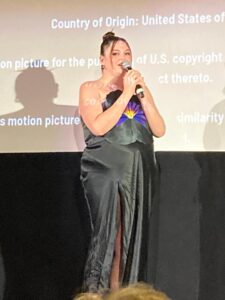
Cora Bora, starring comedian Megan Stalter, best known for her role as Kayla in the TV series Hacks, and recipient of this year’s Next Wave Award, has a promising premise: the music scene in Portland, Oregon is the setting for a quirky character, desperate to be loved. Stalter is funny in the title role, but the overall tone of the film is depressing, as she tries to navigate a “career” that seems more of a pipe dream and manage a “relationship” that clearly really isn’t. The music in the opening sequence is engaging, but quickly disappears, as the main character Cora performs her own material solo in small venues with audiences that are oblivious if not outright hostile. The script shows potential even though it’s often predictable, but the characters are not fully developed. Cora’s parents are totally over-the-top, and we never understand her connection with her girlfriend; they are estranged but in denial about their status from the beginning of the film, with Cora’s relocation to LA to “make it big” as the reason for their separation. Cora returns to Portland to find that her girlfriend has a new live-in girlfriend, and Cora tries to assert her dominance but it’s too late; her parents have fallen in love with the new girl. Cora continues to pursue dating app hookups with men, and delivers one of the best lines in the film: “What? You don’t like bisexuals?” She loses their dog and meets up with some crazy characters, but the plot twists are contrived, including (spoiler alert) the reveal that the death of all her former band members in a car crash is the traumatic source of Cora’s inability to function in the real world and ultimately, be intimate with anyone. An opportunity presents itself in one of the most unique and fleshed-out characters in the film, music industry geek Tom, who recognizes Cora’s talent. The film ends on an upbeat note. The audience loved the film and clearly loves Stalter, who killed in the post screening Q&A. She is a force to be reckoned with, who made the story come to life on screen in spite of the script’s clichés. Stalter continued to dazzle the crowd at the opening night party at the Crown & Anchor, where the rain stopped just in time for drinks poolside.
Thursday morning I opted to see Playland at the Whaler’s Wharf because I had met the director, Geordon West, at an online film networking event when they were just starting to raise funds for the project, and having visited famed venue on Essex Street in what was formerly Boston’s Combat Zone, I was really intrigued and excited to see the finished product. Unfortunately the director was not in attendance, but the film was a very unique hybrid creative piece, fusing elements of memory, poetry, dance, music, and lighting. It opens with a neon sign that looks as though it had been salvaged from the drag club, which operated from 1937-1998, flashing on and off, and it uses what appear to be the ruins of the building’s interior to recreate the world that has since disappeared. Today there is only a parking lot where Boston’s oldest gay bar once stood; the building was demolished in 1998. The audio is often inaudible, sometimes in an attempt to create a ghostly narration, other times because the filmmakers adds archival audio clips of local news broadcasts during venue’s later years, from the Boston busing protests and racist attacks in the 1970s to the redevelopment campaign that wiped out the red light district and its strip clubs in the 1990s. There are audio interviews with Playland’s most notorious star and hostess, Sylvia Sidney, but she is never identified as the speaker so one would have to been a patron to understand the significance of her stories. The use of young actors to recreate characters from the bar’s heyday is very effective, but like ghosts they do not speak. The waiters, kitchen workers, and bartenders engage in a series of choreographed encounters, pastimes and fantasies, accompanied by an operatic soundtrack and fabulous lighting that work together to evoke the other-worldliness of the club and the seedy nightlife of the zone. I will never forget when we went with a performer from Jacques in Back Bay after her show to Playland for last call, and in the bathroom I inadvertently saw Sidney’s piece tucked into her stocking under her dress and I realized that she was not taking any chances. There is some fabulous old footage augmented by performances from Lady Bunny, and the film is worth seeing for that alone, but without a narrative structure, is too slow for a feature-length film, and the poor audio quality detracts from the power of the images. A very impressive experimental first feature nonetheless. Long live Sylvia Sidney, queen of Playland!
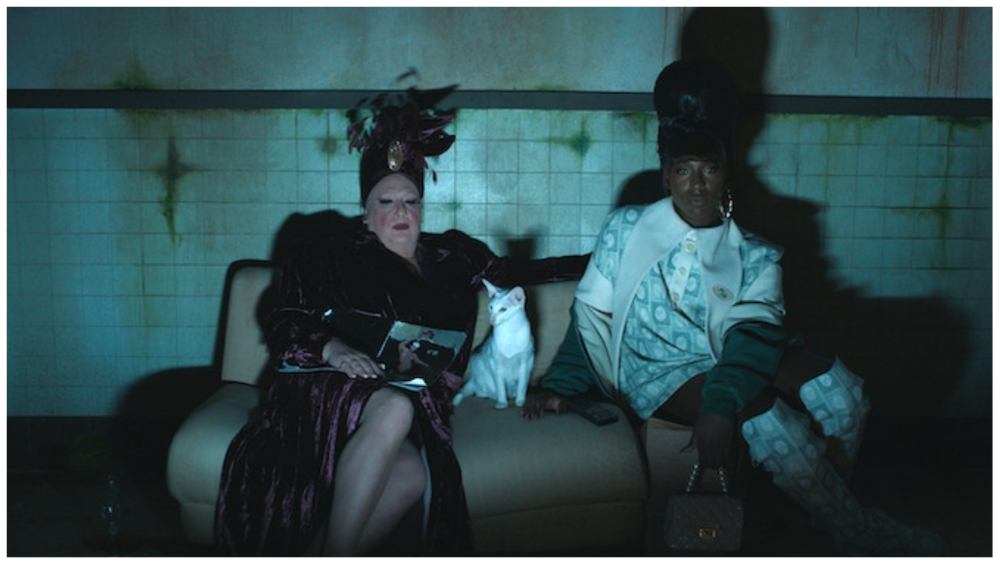
We had lunch at the Filmmaker’s Lounge at Gabriel’s Guesthouse on Bradford Street, with sandwiches from Box Lunch, beer and wine from Provincetown Brewing Company and Truro Vineyards, and pastries from Relish. Vicki, Beth, fellow Chlotrudis member Scot Barton, filmmaker Charlotte Robinson, and I compared notes on films we had seen. It was a beautiful day and several people opted for the pool or the beach, but I went to see the locally shot and produced Art Thief at the Town Hall. Directed by Provincetown gallery owner Arthur Egeli, the film re-imagines the Isabella Stewart Gardner Museum 1990 notorious and still unsolved theft of thirteen paintings from the perspective of obsessive art collectors. The premise is interesting and the plot is based on the known facts about the night of the heist, but using the local Packard gallery as a stand-in for the museum, and other Commercial Street locations for South Boston and Weymouth, require a degree of suspension of disbelief that is difficult at best given how well-known the story is. The cast was great, including lots of Ptown residents, Boston comedian Lenny Clarke as one the rival collectors, and Max Deacon as the misguided thief, and the entire community turned out for the premiere. Producer Judy Richland, another local business owner and filmmaker, joined Egeli, his wife Heather who co-wrote the screenplay, and many members of the cast for the Q&A. The director explained that they shot the film in 5 weeks and never considered filming at the Gardner museum because of the cost. The film effectively captures the art world auction dynamics, and ends with the paintings still safely concealed. It makes one wonder if the famous Rembrandts might in fact be hiding in plain sight. Having worked at the Gardner, I found the concept intriguing.
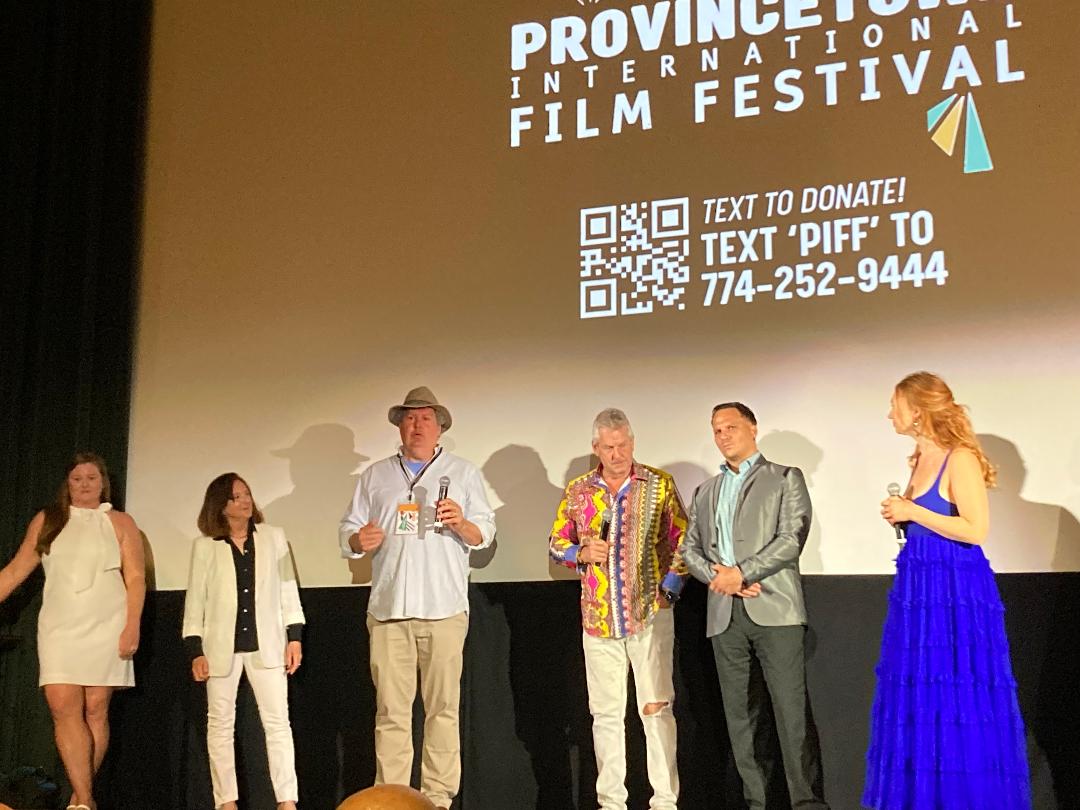
I decided to stay at the Town Hall for the next film, another world premiere. After the Bite, an HBO documentary like many at this year’s festival, tells the story of local surfer Andrew Medici who was killed in a shark attack in Wellfleet in 2018, and the impact of his death on the many different stakeholders on the outer cape. Before the screening started I saw filmmaker Steve Maing walk in, and realized that he must have shot some of the film. Steve was cameraperson on my first two films, directed several award-winning documentaries, and is credited as one of two cinematographers for this film. The film opens with a breathtaking aerial shot of the end of Cape Cod, bookended in the film’s closing moments. The film documents the lives of Medici’s family and friends, the work of environmentalists and the Shark Conservancy Project, the efforts of residents of the lower cape to get legislation passed to mitigate the problem created by the protection of the seal population, and the daily lives of lifeguards, surfers, and the great whites, as they intersect in a beautifully shot and thought-provoking portrait of a complex ecosystem. At eighty-eight minutes total running time, the film presents every possible perspective and then looks to the future. The ending feels a little drawn out but the amazing cinematography holds our interest until the closing shot. After the Bite perfectly captures the challenge of our coexistence in a rapidly changing marine world. I could not stay for the Q&A but ran into Steve later on Commercial Street and told him how much I enjoyed the film.
I met Michael Colford and Beth Curran at Liz’s on Bradford Street for dinner, said hello to John Waters outside MAP on Commercial Street where he had been signing copies of his latest book Liarmouth, ran into the Boatslip for the last song of the tea dance, Last Dance by Donna Summer, and stopped at the Crown and Anchor outdoor bar for a drink before heading to the Filmmakers Party at the Underground. We met Vicki there and we also met Conor McBride, editor of the documentary Hidden Master: The Legacy of George Platt Lynes. I told Conor about my new film project and we exchanged contact info.
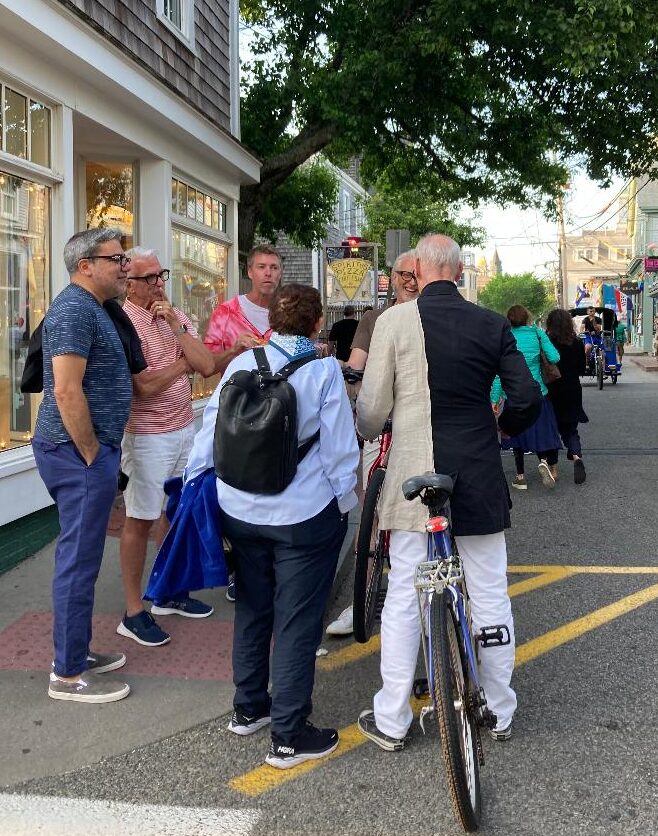
I left the party early to see one more documentary, The Stroll, another HBO produced film, at The Art House. The film, co-directed by Kristen Lovell, tells the story of New York City’s meatpacking district and the trans women who worked the street from a first-person perspective. Lovell, a former sex worker, interviews her friends and former colleagues about their experiences in the 1990s, and includes excellent archival footage from the 1970s onward. This is an important historical film, documenting the discrimination and violence these women faced and overcame, celebrating the triumph of the survivors and their work today as activists and role models for younger trans people. The film ends with a few of the women remembering life on the street known as The Stroll in the now gentrified neighborhood, in a scene that is at once bittersweet and hopeful. This is a film that I will share with my undergraduate students this fall as part of the curriculum in my course on Gender, Identity and Sexuality in Literature, Theater, and Film.
Friday morning I went to The Art House to see Conor’s film Hidden Masters, which he had described as having more footage of male full frontal nudity than any other film in the festival. I had never heard of the film’s subject, photographer George Platt Lynes, but I was aware of many of the people in his art world circle, including Christopher Isherwood and his partner Don Bachardy, Gertrude Stein, and George Balanchine. Although he is best known as fashion photographer, the majority of Lynes’ stunning work was indeed hidden in a huge collection owned buy one of the Koch brothers until the director, Sam Shahid set out to rediscover the artist’s extensive portfolio and bring to light his significance as an openly gay man whose images celebrate the male body. He was clearly the predecessor to Mapplethorpe as well as Avedon. Lynes is revealed to be a fascinating character, supremely talented, charismatic, and entirely self-centered, like so many geniuses. According to his friends, lovers, and colleagues interviewed for the film, his relationships were complex and sometimes abusive, he always lived beyond his means and twice faced bankruptcy, but he also had the ability to bring creative people together to collaborate and innovate. Everything revolved around Lynes; he was the center of attention, a fulcrum. At the post-screening Q&A the director talked about the work as a passion project, where for ten years he kept uncovering new materials, finding new people to interview, and putting together a complete portrait of the man and describing the process as a kind of archeology. As a documentary filmmaker and a devotee of Isherwood’s work, I could relate to the joy the team experienced when they found the archival footage of Lynes, Isherwood, and Bachardy in New York in 1955, one of the last images of the famed photographer before his untimely death from lung cancer at the age of 48. Editor Conor McBride talked about finding the four-act structure for the story, focusing on the rise, peak, fall, and legacy of a forgotten master. The film preserves the fabulous parties, the early days of Queer Modernism, and authenticity of an artist whose work was never compromised by his commercial success.

After a quick lunch at Gabriel’s I went back to Art House to see Rock Hudson: All That Heaven Allowed directed by Stephen Kijak. Yet another HBO production, the film deftly combines home movies of Rock on vacation with his lovers, interviews with stars who knew him including Armistead Maupin and Linda Evans, television appearances from later in his career, and very creative manipulation of clips from his films to tell the story of the world famous movie star who came out publicly and helped bring awareness of the AIDS crisis to millions, along with his friend Liz Taylor. The early days of his arrival and subsequent grooming in Hollywood closely echoes the world depicted in Ryan Murphy’s series of the same name. His agent carefully crafted and protected Rock’s image as a heterosexual heartthrob, while taking advantage of young male actors in an age where the casting couch was a very real requirement for success. Hudson was blackmailed at several points because of his sexuality, and even after his death, there were attempts to discredit him in several different biographies, including one by his ex-wife, who claimed she had no idea he was gay. Given that she was said to have been bisexual, it’s difficult to understand her motive for publishing her allegations. Ultimately, the world will now recognize his raw talent, professionalism, and generosity thanks to filmmakers. In the Q&A the director explained that they based the film on what is considered to be the definitive biography and had the cooperation of his estate. The end of his life was tragic; after being diagnosed with HIV he was refused medical treatment in France, had to pay for a private jet to return to the United States, and an appeal was made to Nancy Reagan to admit him to a hospital on Washington, D.C., which was also refused. As sad as the ending of his life was, the film ends on an optimistic note. His public statements marked a major turning point in the fights against AIDS, with the Foundation founded by Taylor raising millions in the immediate aftermath of the announcement. For today’s students, who did not grow up with Rock Hudson and Doris Day sparring together on the big screen, this film provides another very valuable lesson in the history of the industry and the gay rights movement, but it is never maudlin. It celebrates the brilliant actor by cleverly repurposing the many film roles he brought to life; it is as entertaining as it is educational.
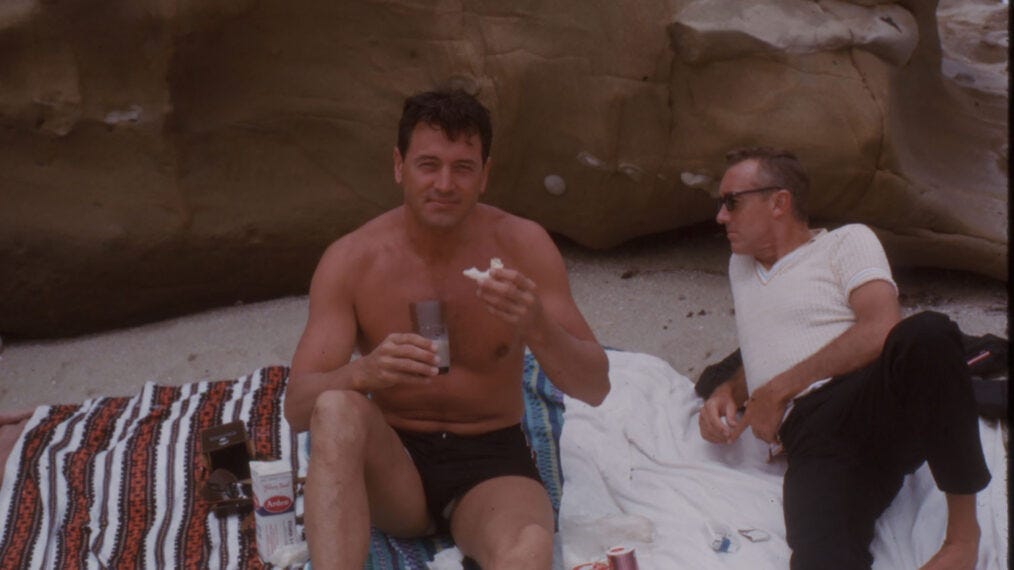
After a quick break, I headed back to Art House for the special preview screening of the TV docu-series Never Let Him Go. A collaboration between Hulu and NBC, the series investigates the deaths of hundreds of young men ruled suicides at gay “beats” in Australia. The story focuses on the death of Scott Johnson, an American student found dead at the bottom of a cliff in Sydney in 1988. Since then, his family has relentlessly sought answers to the mystery of his death, also ruled a suicide but without any corroborating evidence. His parents and siblings knew that he was gay and supported him unconditionally, something that Michael Colford, host for the Q&A, pointed out was unusual at the time. Scott’s older brother Steve leads the search for answers in this four-part series, and as the first two episodes unfold, it becomes increasingly clear that police negligence and corruption are major factors in what appears to be a cover-up. As a result of the filmmakers’ efforts, one person was recently convicted of murder and a new commission has been appointed to look into the many unsolved cases. In the Q&A, Steve explained that it was easier for him to investigate from his home in America; people in Australia are still afraid of and intimidated by the police. He talked about going to Europe with his brother Scott who had met another young man at Cambridge University, fallen in love, and come out while in school there. On that trip Steve said they talked at length about what it meant to be gay. Host Michael Colford praised the family for their commitment to bring Scott’s story to the public, and to help bring justice for the hundreds of other gay men whose lives were cut short. An excellent series; looking forward to the next two episodes!
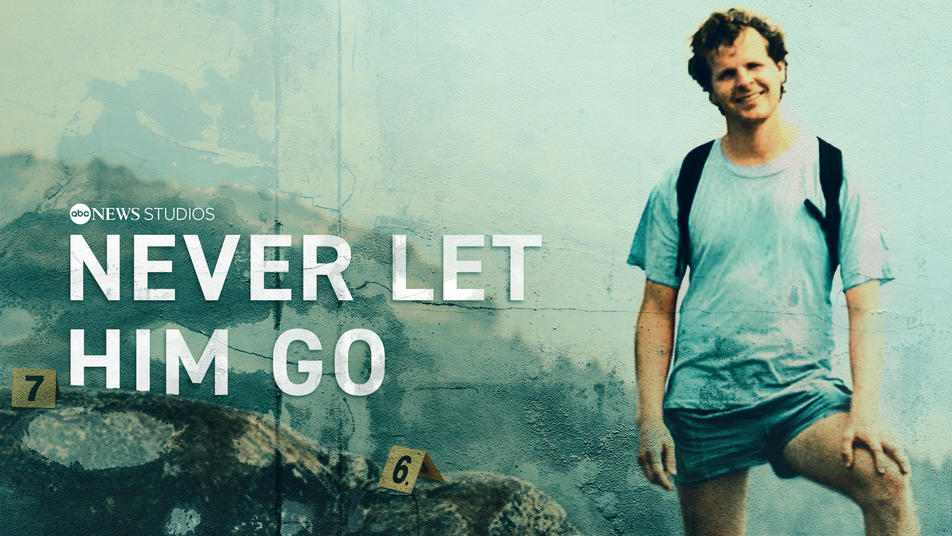
Next up was the clambake at Herring Cove, a fundraiser for the Provincetown Film Society and Festival, which I attended with PIFF board member Michael Colford. It had been a hot and sunny day, but the clouds rolled in just after 5 p.m., cooling the evening air and precluding a sunset. We stopped at Michael’s place in the West End first, so as not to be the first to arrive. John Waters made an appearance accompanied by Filmmaker on the Edge honoree Bruce La Bruce, and everyone enjoyed cocktails, corn on the cob, clam chowder, cornbread, southern style potato salad, and lobster. We shared a table with other board members, including an attorney from D.C. who knew about the subject of my last film, the Shakespeare authorship question, and a producer who had a short film about dance in the festival, who said she loves Shakespeare and was very interested in his sexuality. It was an evening of great networking in a beautiful venue. The bonfire was just getting started when we left for the next party.
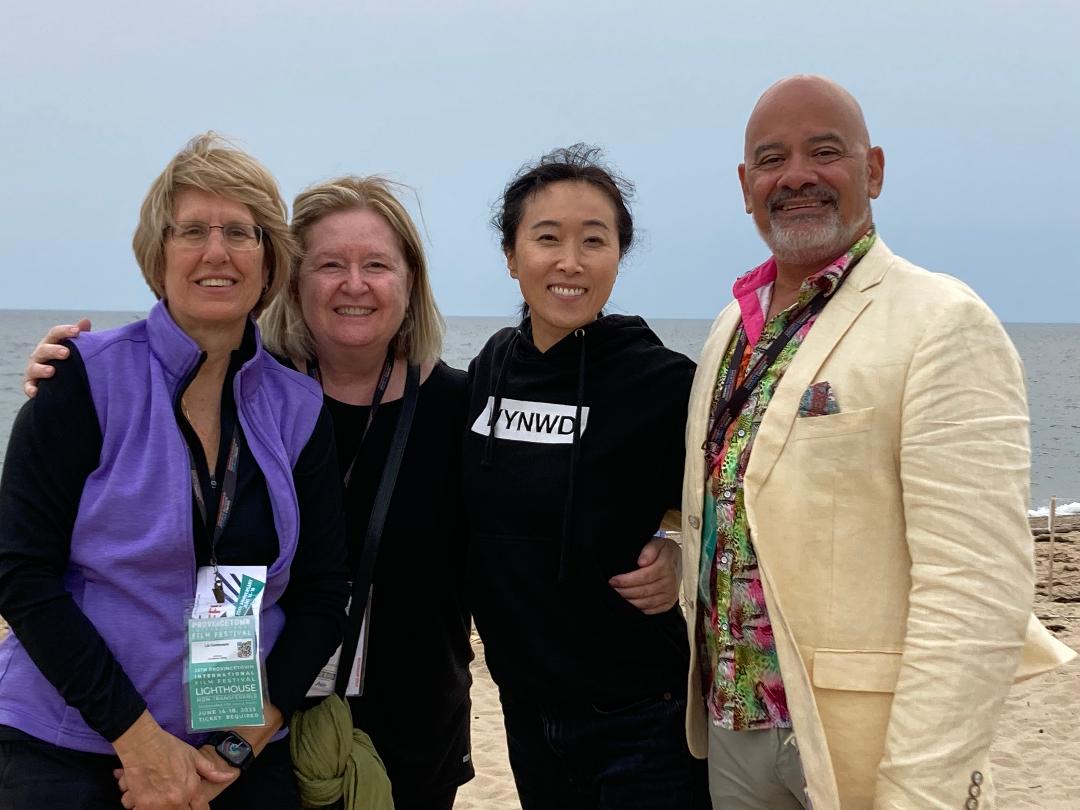
We stopped at our AirBnb on Bradford Street for a quick break before walking to the School House Gallery around the corner. Always the best party of the festival, this year’s soiree did not disappoint. The stars were out in full force. Billy Porter, recipient of the Excellence in Acting Award, arrived first with a small entourage, sporting an “Amazing Technicolor” caftan. He headed to the back room of the gallery for a prefab cocktail, and graciously “Posed” for photos with other filmmakers and fans, including me. I did not see him on Broadway in his breakout role in Kinky Boots, but absolutely loved him in Pose, and could not resist the opportunity to meet him. He is a true fashion icon and fearless innovator, and I told him if he wanted a real cocktail, go to Strangers and Saints a few blocks up the street. John Waters, self-appointed godfather of the festival and as I like to think of him, our American Fellini, arrived next. He spent quite a bit of time talking with Megan Stalter and other filmmakers before making his way to Billy and greeting him. It was a lovely pas de deux – two superstars holding hands, at arms’ length (john told me the day before he does not hug anyone post COVID!) – a moment when worlds collided in a true celebrity supernova! I told John as he left the party that he looked fabulous as always. I talked to journalist Loren King about my new film project and her new essay about being a projectionist at a porno theater in Boston. I told Megan her dress and make-up were stunning, and then we all left by 10:00 p.m. A perfect ending to a fantastic day of films, TV, and parties.
Saturday morning we checked out of our AirBnb and took an Uber to the Town Hall, It was raining and Vicki and I were taking the 3 p.m. ferry back to Boston. We went to the Post Office for breakfast, and then I went to see my last film, the 10:30 a.m. screening of Egoist, a narrative feature from Japan: a beautiful, sad, very
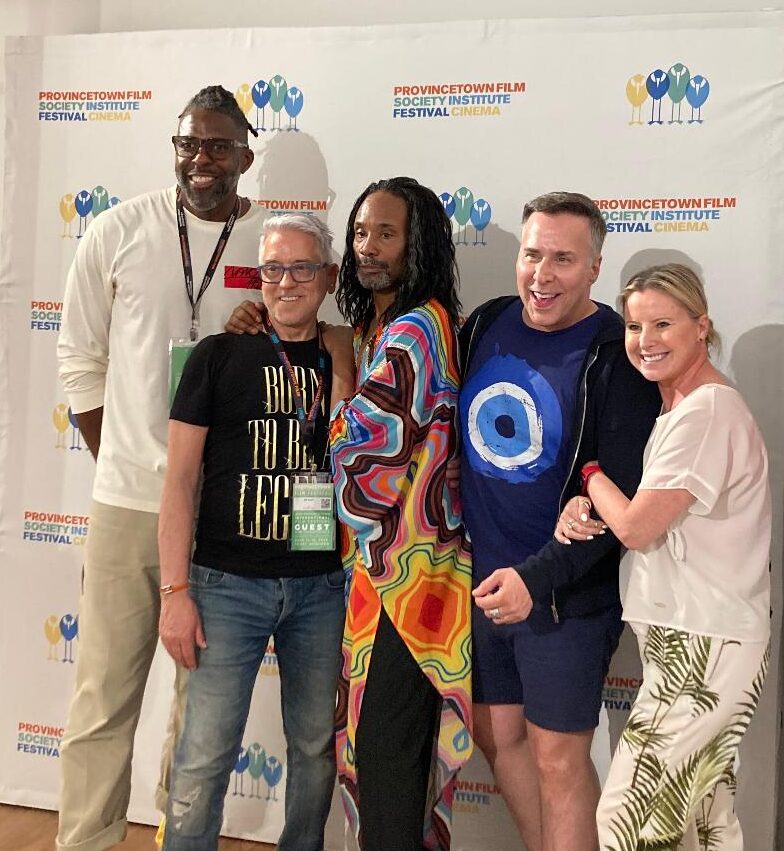
modern film about love, intimacy, and family. The main character, a successful fashion magazine editor, is clearly lost until he meets a young personal trainer who also moonlights as a sex worker. Their intense relationships first ends abruptly when the trainer confesses his other profession, and the editor begs him to allow him to pay for exclusive access to his services, ostensibly to help him support his widowed mother. The protagonist Kosuke lost his own mother when he was only fourteen years old, was bullied for being gay at school, and talks about clothes and wealth as “armor” to protect himself. Their new arrangement works well. He meets Ryuta’s mother and she accepts him; she knows Ryuta loves Kosuke. The affair ends suddenly a second time with Ryuta’s death, which is never explained but devastates Kosuke. He builds a new relationship with Ryuta’s mother, caring for her until she is dying. An exquisite, emotionally powerful film. In one of the final scenes, Kosuke says, “I don’t even know what love is” and his new mother says, “We know you love us. That’s enough.” A new twist on the concept of found family, brilliantly rendered by director Daishi Matsunaga’s in his adaptation of Takayama Makoto’s novel.
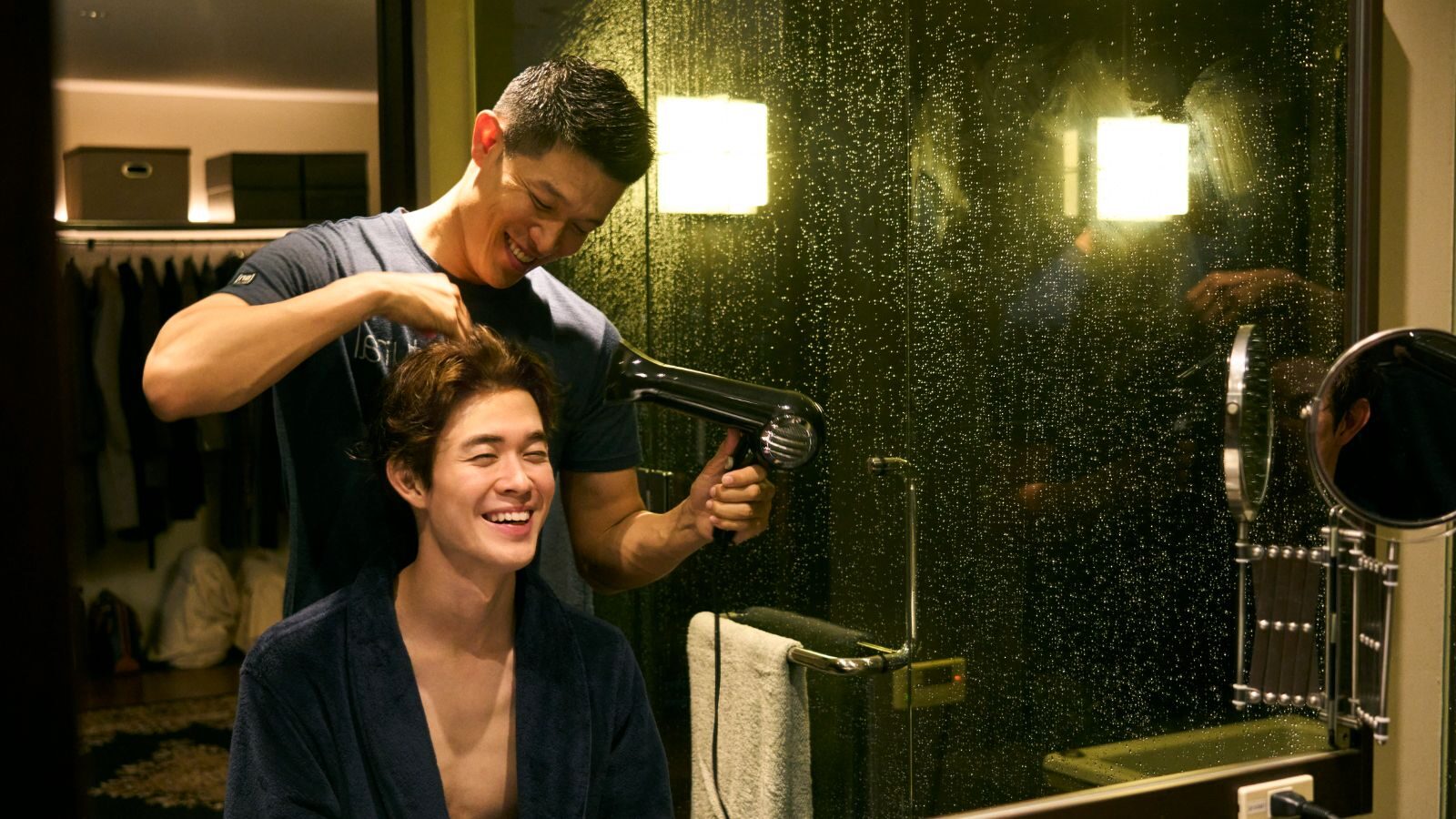
I met Vicki at the filmmakers’ lounge for lunch and we headed to the ferry. As we left the harbor, there were only about ten people on the upper deck, even though it was not too cold or windy. I hated to leave before the awards presentations on Saturday night, and wished I had had time to see more films, but the Provincetown International Film Festival is one of the best in the country, and I always enjoy it no matter how long I stay. Leaving Provincetown is always difficult for me, even knowing that I would be back in two weeks for a ten-day vacation after a week of filming in London. There was a light drizzle as ferry pulled out and the town disappeared like Brigadoon into the mist and haze, into so many shades of gray where the ocean meets the sky, a truly cinematic parting shot.
